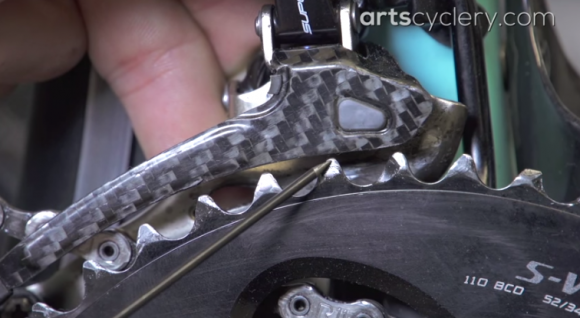How to Adjust Campagnolo Front Derailleurs:
The foundation that every good front derailleur tune is built on is correct derailleur alignment. Start by setting the position of the front derailleur. With the derailleur shifted into the small chainring you want the outside edge of the derailleur cage to sit 1.5 to 3 mm above the top teeth on the large chainring. Closer to the low measurement will help with chain retention. The outward edge of the cage also needs to be set parallel with the large chainring.

Front Derailleur Cage should sit 1.5 to 3 mm above the top teeth on the large chainring
Once you have the derailleur where it should be, tighten the front derailleur mounting bolt to 7nm. With the position set we can move on to the limits and cable tension adjustment.
It is a good idea to work from the inside to the outside of the adjustments. That means setting the low limit, followed by the cable tension, and then the outer limit.

Set the low limit, followed by the cable tension, and then the outer limit
Set the low limit by first shifting the rear derailleur into the largest cog. Now adjust the low limit screw. This is the one closest to the frame. Adjust so that the inside edge of the derailleur cage is as close to the chain as possible without rubbing. Ideally, that means you’ll just have a .5mm clearance between the chain and the derailleur cage. Turning the limit screw clockwise will move the derailleur outward, while turning it counter-clockwise will allow it to move inward.

Use cable anchor to set cable tension
Now, we can set the cable tension. With proper cable tension, you should be able to shift from the small ring to the big ring with just 3 clicks of the shifter. To get this set, loosen the cable anchor, and then turn your cable barrel adjuster if you have one. Release all the cable by pulling on the cable while pushing down on the hood mounted paddle repeatedly until the shifter no longer reels out cable. Pull the cable tight and anchor it by tightening down the anchor bolt. Shift your rear derailleur and perform some test shifts to see if it shifts properly. If not, try pulling the cable tighter and re-anchoring. If your derailleur executes the shift in two clicks, then it is two tight and steps should be reversed.
With cable tension set, we can now move on to our high limit. Shift the rear derailleur into the smallest cog. Then adjust the limit screw so the outer plate on the derailleur cage gets as close to the chain as possible without rubbing. Test and fine tune.